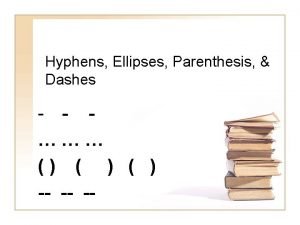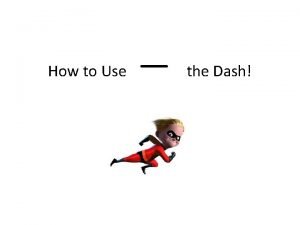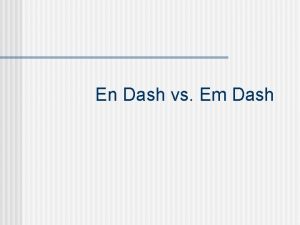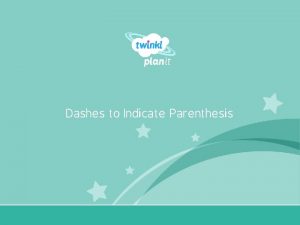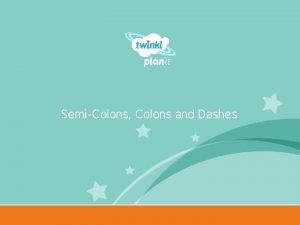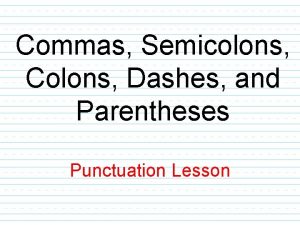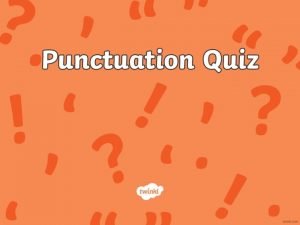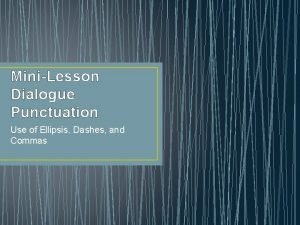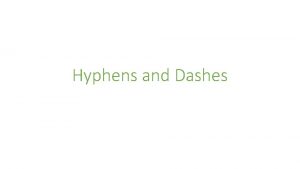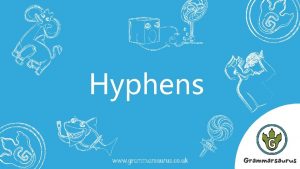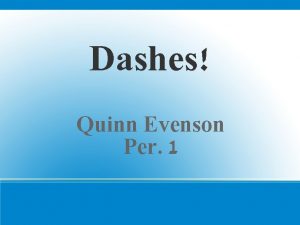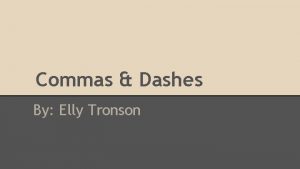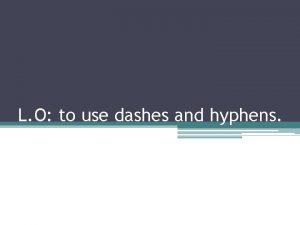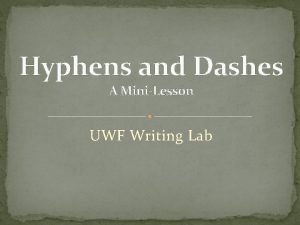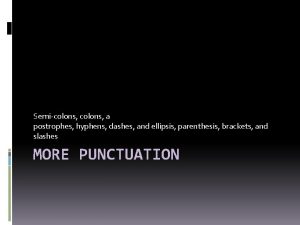Dashes vs Hyphens General Definition Hyphens Hyphens used










- Slides: 10

Dashes vs. Hyphens

General Definition: Hyphens � Hyphens: (-) used to connect two or more words (and numbers) into a single concept, especially for building adjectives. � Note that a hyphen never has spaces on either side. � Example: There are fewer Italian-American communities these days.

General Definition: Dashes � Dashes: (-) used to connect set content off from the rest of a sentence � Note that a dash is LONGER than a hyphen. � Example: There was only one person suited to the job—Mr. Lee.

Using Dashes � Use a dash to indicate a sudden break or change in the sentence. � Example: Near the end of the month—and this is not always true—you can spot more unicorns in the Lollipop Forest. � Use a dash to set off an introductory series from the clause (can stand alone) that explains the series. � Example: An emu, a penguin, and a chicken —these are all examples of birds that cannot fly.

Using Dashes � Use a dash to set off parenthetical material —material that explains or clarifies a word or a phrase. This material will INTERRUPT your sentence. (You could also use commas or parentheses for the same effect. ) � Example: My husband—the cutest guy on earth—is a farmer. � Use a dash to indicate interrupted speech. � Example: ◦ ISABELLE 1: Mama, why are you— ◦ MAMA: Isabelle, do as I say!

Using Dashes � Use a dash to emphasize a word, a series, a phrase, or a clause (like you would with a colon). � Example: After years of trial and error, Ms. Pohl finally made history with her discovery—the Sasquatch.

Using hyphens � Use a hyphen with some prefixes, especially all-, co-, ex-, great-, numbers, and capital letters. � All-knowing, allaround, Co-conspirator, co-author, ex-husband, ex-convict, greatgrandmother, greatuncle, 35 -cent piece of candy, 40 -foot tree, Tshirt, PG-rated � Use a hyphen when a word would be confusing or hard to read without it. � Shell-like (shelllike would have three l’s in a row) � Anne recovered from the flu and recovered her living room chair. � The fried-chicken salesman was hot, greasy, and unhappy.

Using hyphens � Use a hyphen with double last names. � Mary Scott-Simons � Jim Blake-Adams � Use � � Use hyphens with dates. 11 -5 -07 hyphens with numbers from 21 to 99. � Twenty-one � Thirty-six a hyphen with scores. � We beat our arch rivals 86 -78. a hyphen to mean through. � Read pages 16 -24 before class tomorrow. � The store is open Monday-Saturday.

Using hyphens � Use hyphens in compound adjectives if they come before the noun they describe. � The 15 -year-old girl � Up-to-date technology � Eight-grade students � If they compound adjective comes after the noun, don’t use hyphens. � The girl was 15 years old. � The technology is up to date. � The students are eight graders.

Using hyphens � Use hyphens to spell out words. � She said, “My name is Kacey, Ka-c-e-y. ” � Use hyphens to show faltering speech. � Oh no! Y-y-you t -t-took my pl-plplums!
